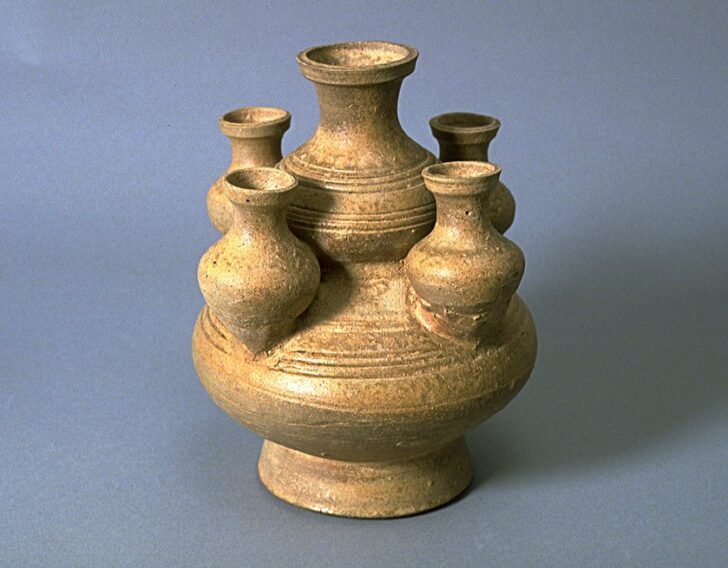Five conjoined pots
Chinese

Description
4. Five-bodied pot
Southeast China, Eastern Han, 25–220 or Eastern Wu dynasty, 222–80
Stoneware with ash glaze on shoulder
Gift of Domino’s Pizza, Inc., 1993/1.99
This vessel is shrouded in mystery. The smaller jars are attached to the main container, but do not open into it. Since pouring from this vessel would be awkward and it is unlikely that it was used in everyday life, scholars have proposed that this multi-bodied pot was for the storage of grain in a funerary context. Pots with five false spouts possibly held the Five Grains (wheat, rice, barley, maize, and sorghum) of China or a wine known as wu liang ye that was brewed from the five grains and formed part of ancient Chinese burial rites.
Subject Matter:
Clustered pots of the same form can be seen as early as the Neolithic period in China, and can be seen in bronze as well. In the Han Dynasty, remains of foodstuffs can be found in these types of jars to provide for the deceased in the afterlife. Conjoined pots such as this have been excavated from Western Han tombs in Guandong (Canton), Hunan, and Guangxi. By the Western Han dynasty, basic household bowls, plates, basins, jars, etc. were produced in great quantity, not only for use in daily life, but also specifically for tombs as mingqi (明器, bright objects), or grave goods, as a way to provide for the deceased. These mingqi included everything one would need during the afterlife, naturally, these objects reflected daily life during the Han. Mingqi could include houses, towers, gates, granaries, livestock pens, chicken coops, wells, cooking stoves, storage vessels, dishes, incense burners, lamps and figures such as horses, dogs, anthropomorphic animals, and people such as officials, guardians, servants and entertainers, and more. The number of ceramic mingqi items in a tomb could reach numbers of a few to several hundred objects.
Physical Description:
This is a stoneware ceramic pot on a tall foot ring with one large central globular body topped with one large central hu-shaped pot and four smaller hu-shaped pots that encircle it. The upper and lower body of the main pot is decorated with bands of incised bowstring decoration. It is covered by a thin layer of accidental ash glaze.
Usage Rights:
If you are interested in using an image for a publication, please visit https://umma.umich.edu/request-image/ for more information and to fill out the online Image Rights and Reproductions Request Form.